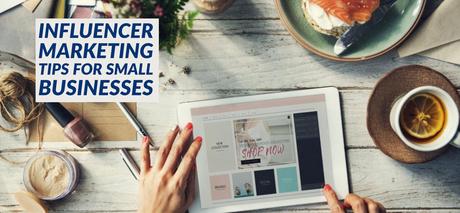
Which would you trust the most – results of the organic search result on Google, a sponsored Ad on search engine/ social media or an endorsement by a trusted blogger or social media influencer whom you follow and admire? Influencer marketing is growing rapidly and according to eMarketer the global spend on Instagram alone was $570 million in 2017.
A common misconception about using influencers for marketing your brand is that it can be too expensive for small businesses. You do not need to use celebrities or big influencers with a million followers. Micro-influencers can help promote small businesses at a fraction of the cost. Micro-influencers are experts, opinion-shapers and trend-forecasters who have between 1,000 and 50,000 followers on any platform, and many have their own blogs and websites. Micro-influencers are focused on a targeted niche.
Though micro-influencers’ followers are lesser in number, the engagement they can generate is generally higher, at an average around 8 percent, compared to 4 percent for those with over one million followers. A study by Keller Fay Group revealed that compared to an average consumer, micro-influencers have 22.1 times more conversations each week involving brand purchases and recommendations and that 82% of consumers are “highly likely” to follow influencer recommendations.
How to Find Micro Influencers
Start your search by scanning your existing followers. A fan who frequently comments on your pages uses your custom hashtags or tags your company could be an influencer. Check how influential she is using tools like Follerwonk.
You can search for social media platforms like Instagram, Twitter, LinkedIn and Facebook using hashtags, especially branded hashtags: search #YourBrandName, #competitorbrand, #yourproduct on Instagram, Twitter, or Facebook.
Check if the influencer produces quality content, which you would want to be associated with.
An influencer’s number of followers and reach are not necessarily the most important factors. Engagement rates—or how many of their followers actually engage with their content by commenting, sharing, liking, or clicking links, for example—are more important. Experienced influencers will provide this information if they’re interested in collaborating with you.
Don’t rely on raw follower numbers when searching for influencers, though. If you see a sudden spike in the number of followers, most likely these were bought.
To find micro influencers on a scale, you can tool focused on influencers. Some of these are free or freemium. The tools will provide statistical data on the influencers.
Scrunch is a freemium tool which helps you to find micro-influencers quickly. It boasts of 20 million profiles of influencers on blogs, Facebook, Twitter, YouTube, and Instagram. You can execute outreach and marketing campaigns. You can search influencers by topic, hashtag, location, reach, engagement and more. The data provided includes follower size, the social platforms the influencer uses, the cost to have them create content for you and the topics they post about.
Tinysponsor makes it easy for micro-influencers and enables businesses to collaborate. Influencers can set up sponsorship packages and set price for what they want to offer. It allows businesses to search sponsorship packages by platform, price, city, tags, and more. You can buy a package and work directly with each influencer.
Unity is a new platform that uses machine learning to connect small businesses with micro-influencers. By utilizing artificial intelligence, Unity makes the influencer marketing process simpler for businesses. Once a business signs up, it takes about 4 minutes to create a campaign. Then, Unity takes the metadata and passes it through the influencer database. This metadata is matched with various data points of an influencer, including interests targeting, affinity targeting and geo-targeting.
HYPR has a database of 3 million influencers along with the demographic data of their followers. You can search for influencers with 1,000 to 10,000 followers, with an audience interest, and filter on typical demographics of your customer base. You can further drill down the results based on the influencer attributes, like her location, follower count, and the social platform
Five ways to Use Micro-influencers to Gain More Customers
-
Creating Custom Hashtags:
Creating Custom Hashtag for each campaign is one of the best ways to generate brand awareness and drive engagement. You can send out free products for promotions to these influencers and have them generate content on social media on their channels.
Hawaii’s Department of Tourism has very effectively used micro-influencers who are travel bloggers or Hawaiian natives to contribute content for its #LetHawaiiHappen Instagram campaign. In the example below, it collaborated with photographer Rick Poon to post photos from his trip to Hawaii.
We can’t resist following @rick_poon and his travel and food adventures on Oahu and Kauai this week! Double tap if you’re craving some guava chiffon pancakes and kalua pork benedict right now. #LetHawaiiHappen
A post shared by Hawaii (@gohawaii) on Sep 12, 2015 at 8:22pm PDT
-
Leverage User-generated Content:
The benefit of using influencer-generated content over user-generated content is that influencers tend to know what they’re doing. Influencers live and die by camera angles and lighting, creating watchable videos or readable blog posts. The simplest way is you can have the influencer create the content and share the content on your brand page, and give credit to the influencer.
Buffer regularly uses influencer-generated content like this photo by @puffinandbennie
All smiles heading into the new week
Have a great one, everyone! . . Puppy love
with #BufferCommunity member @puffinandbennie
A post shared by Buffer (@buffer) on Sep 17, 2017 at 7:22pm PDT
-
Create Sponsored Posts:
Sponsored posts are similar to user-generated content, but here you focus on getting the influencers to post the content on their own accounts. Often influencers do not spend on sponsored posts. You can pay for promoting these posts or simply share them on your brand profile.
-
Micro-influencers Promote Discount Codes & Deals:
Offering consumers a discount or a deal is an excellent motivator to drive sales. You can have micro-influencers promote discount codes and deals to drive their followers to try your product. Or they can promote a giveaway campaign for free products.
-
Social Media Takeover:
Here you allow an influencer to temporary take over your social media account. Snapchat takeovers and Instagram takeovers are on the rise. Examples of takeovers are:
Twitter Takeover: A Q&A session hosted by an influencer is a very effective strategy for gaining new followers and positive engagement.
Facebook Takeover: On Facebook Live broadcast the influencer or expert interacts with your Facebook fans in real time. For the Live session, you would assign the influencer as a Live Contributor.
Instagram Takeover: influencers featured in your account’s Instagram Stories and Live videos hosted by them
Measurement is the biggest challenge for marketers when using influencer marketing.
Here are some general statistics to measure influencer marketing campaign:
- Reach and engagement with each post made by an influencer
- Increase in your social media following
- Website visitors received as the result of the influencer marketing campaign
- Sales generated compared to the costs of working with your influencers
Conclusion
Influencer marketing is one of the most effective forms of gaining mindshare with your ideal consumers quickly and effectively. Because of their high engagement rates and cost-effectiveness, most small businesses can leverage micro-influencers anytime, even with a limited budget.
This article originally appeared in https://www.livedigitalmarketing.com/how-small-businesses-tap-into-power-of-micro-influencers/



